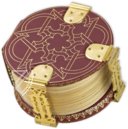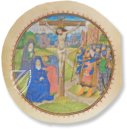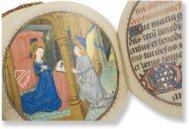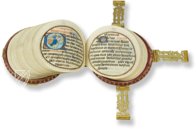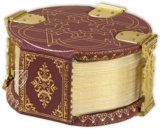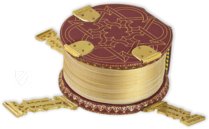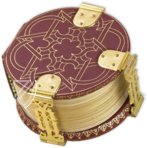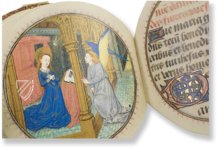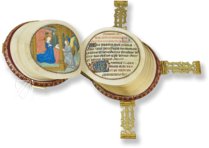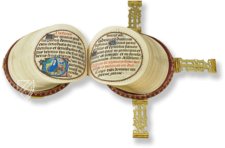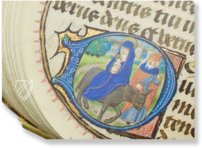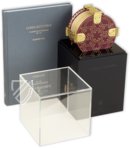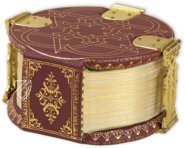Codex Rotundus
This is no extravagant gimmick, but rather book illumination and bookbinding artistry of the utmost excellence: the only surviving round book from the Middle Ages consists of 266 almost circular parchment leaves with a diameter of only 9 cm. What a bookbinding feat to hold them all together with a spine of only 3 cm! Therefore, three gold clasps, each crafted in the shape of a Gothic monogram, help to hold this small and fragile treasure together when closed. The painter of this Codex Rotundus, who collaborated with the famous Master of the Dresden Prayer Book in Bruges in at least one case, was obviously inspired to reach his peak form by the challenge of the tiny format. The three full-page, round miniatures are certainly an astonishing result. And even more concentration on the essentials may have been necessary for the even smaller 30 historiated initials, each of which tells its own story. A true unicum of medieval book production!
Codex Rotundus
Medieval and early modern book culture has produced outstanding and extraordinary manuscripts time and time again: luxury bindings, illustrations generously endowed with gold and silver, written on magenta colored parchment. However, good things often come in small packages, and so is the case with this manuscript: it fascinates not only due to its small size, but moreover because of its form. The Codex Rotundus is a 266 page book of hours in Latin and French. The manuscript is unique in form and size: the pages are approximately circular in shape and measure a little over 9 cm in diameter. The feat of book binding here is enormous: since the layers are bound together on a mere 3 cm book spine, the body of the book is be held together by 3 clasps. The original clasps were re-used when the book was rebound in the 17th century; each clasp is an artful monogram shaped in the form of different gothic alphabetic letters.
Patronized by the Duke of Cleves?
Evidence for whom this opulent and entertaining book was originally intended can be found in initial “D” in folio 24r, which introduces the Divine Office to the Holy Cross: the first text after the French calendar. This initial “D” contains a coat of arms in its interior, which the next owner of the book had apparently attempted to erase. However, one can still make out small pieces of reddish Cleves carbuncle and golden flecks from the chequered balk of the County of Mark, as well as a blue heart-shaped shield. Therefore, it can only be assumed that the first owner of this manuscript was most likely also its patron: Adolph of Cleves.
Adolph of Cleves and the Dukes of Burgundy
Adolph of Cleves, Lord of Ravenstein and Winnendahl (1425–1492), was from a noble family with the strongest of ties to the court of the dukes of Burgundy. He was the nephew of Phillip the Good, Duke of Burgundy (1396–1467) and having been raised in this court, he participated in all the great campaigns of his uncle’s reign. Charles the Bold (1433–77), son and successor of Phillip the Good, later named Adolph Viceroy of Arras and finally appointed him to Governor General of the Netherlands in 1475. The connection between Adolph and the Burgundian court would be yet further strengthened through his marriage with Anna of Burgundy (1435–1508), one of the illegitimate daughters of Philip the Good and governess to Mary of Burgundy (1457–1482), granddaughter of Phillip the Good. Mary herself became so fond of Adolph that she chose him as godfather of her first-born child, Philip I, in 1478. After Mary's death, Adolph of Cleves was appointed Regency Council for their son by her husband Emperor Maximilian I (1459-1519).
A Display of Wealth and Taste
When one considers all these royal ties strongly influencing Adolph, it becomes clear not only why he chose to have his book of hours made in the Bruges workshop, but also his desire to possess such an extravagant and extraordinary book. While at the Burgundian court, he had come in contact with the most highly developed book culture, whose innovation was admired by all. References to Adolph are also found in the monogrammed clasps which fasten the book. The unusually stylized letters cannot be read clearly to this day. However, the same decorative letters adorn some borders of another book of hours owned by Adolph in Baltimore (Walters Art Gallery, W 439). In folio 13v/14r of this book one finds the fully preserved painting of the coat of arms from Adolph of Cleves, removing any doubt as to the identity of the coat of arms in the Codex Rotundus.
The Flemish School with an Individual Character
Not only are the individual pages in a round format but so are the text and three full-page miniatures. These unique features, as well as the 30 historiated initials come from one of the most highly regarded original book painters who has gone down in art history following the Hildsheim manuscript as the “Painter of the Codex Rotundus”. Stylistic parallels tie the painter of the Codex Rotundus to yet another great Bruges book painter, the “Master of the Dresden Prayer Book” whom we know our painter worked with on at least one occasion. More than likely, the painter of the Rotundus had also worked for some time in the Bruges workshop of the Dresden Master and was therefore inspired by many different stylistic perspectives.
Codicology
- Size / Format
- 266 pages / Diameter: 9.3 cm
- Origin
- Belgium
- Date
- End of the 15th century
- Epochs
- Style
- Genre
- Script
- Gothic
- Illustrations
- 3 full-page miniatures, 30 historiated initials, coats of arms
- Content
- Book of hours
- Patron
- Adolf of Cleves, Lord of Ravenstein (1425–1492)
- Artist / School
- Painter of the Codex Rotundus
Codex Rotundus
Massacre of the Innocents
Despite its small size, this historiated “C” initial contains an artful depiction of King Herod’s infamous order and shows him and his soldiers dressed in the arms and armor of the 15th century: “Then Herod, when he saw that he was deceived by the wise men, was exceedingly angry; and he sent forth and put to death all the male children who were in Bethlehem and in all its districts, from two years old and under, according to the time which he had determined from the wise men.” (Matt. 2:16).
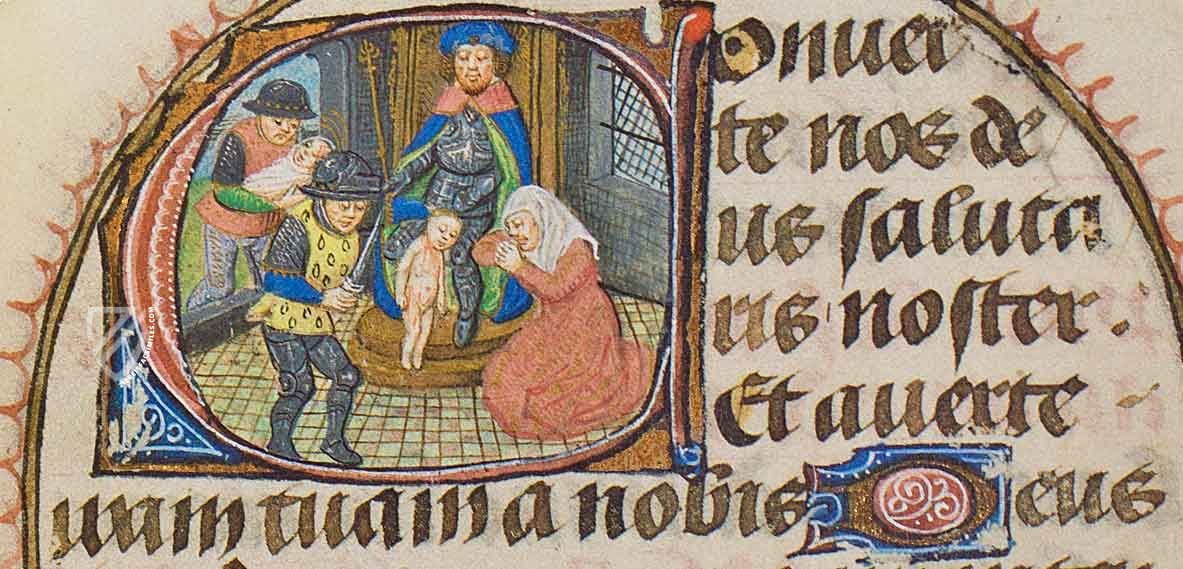
Codex rotundus
The Crucifixion
The sophistication and detail of this round miniature is all the more impressive when one considers that it has a diameter of only 9.3 cm. Although the master responsible is unknown, the image bears all the hallmarks of fine Gothic Illumination: elegant, elongated, figures, a wide variety of bright colors, a dream landscape, and embellishment with gold pen strokes to emphasize the halos and clothing of the righteous.
Jerusalem is depicted with French Gothic architecture in the background. Christ, pale and on the verge of death, looks down at his grieving mother, who is comforted by one of the Twelve Apostles, Peter perhaps, as Mary Magdalene looks on. Roman soldiers dressed as 15th century mercenaries look on, as does a well-dressed Pharisee.
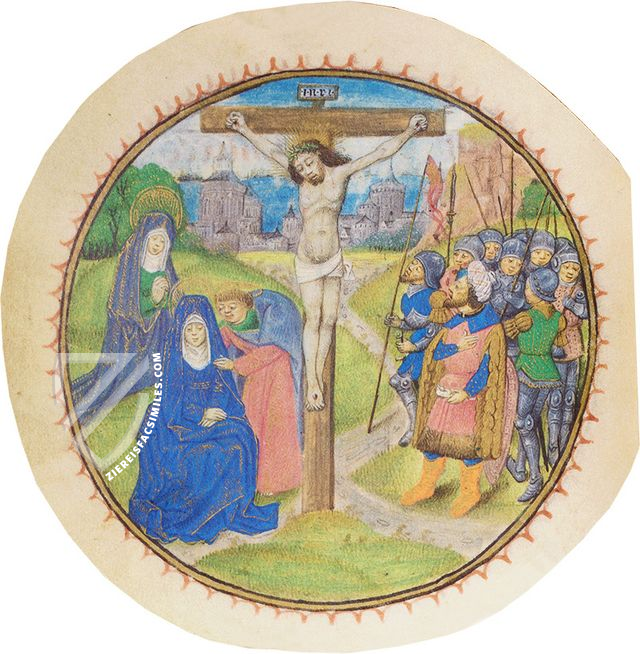
#1 Codex Rotundus
Language: German
- Treatises / Secular Books
- Apocalypses / Beatus
- Astronomy / Astrology
- Bestiaries
- Bibles / Gospels
- Chronicles / History / Law
- Geography / Maps
- Saints' Lives
- Islam / Oriental
- Judaism / Hebrew
- Single Leaf Collections
- Leonardo da Vinci
- Literature / Poetry
- Liturgical Manuscripts
- Medicine / Botany / Alchemy
- Music
- Mythology / Prophecies
- Psalters
- Other Religious Books
- Games / Hunting
- Private Devotion Books
- Other Genres
- Afghanistan
- Armenia
- Austria
- Belgium
- Belize
- Bosnia and Herzegovina
- China
- Colombia
- Costa Rica
- Croatia
- Cyprus
- Czech Republic
- Denmark
- Egypt
- El Salvador
- Ethiopia
- France
- Germany
- Greece
- Guatemala
- Honduras
- Hungary
- India
- Iran
- Iraq
- Israel
- Italy
- Japan
- Jordan
- Kazakhstan
- Kyrgyzstan
- Lebanon
- Liechtenstein
- Luxembourg
- Mexico
- Morocco
- Netherlands
- Palestine
- Panama
- Peru
- Poland
- Portugal
- Romania
- Russia
- Serbia
- Spain
- Sri Lanka
- Sweden
- Switzerland
- Syria
- Tajikistan
- Turkey
- Turkmenistan
- Ukraine
- United Kingdom
- United States
- Uzbekistan
- Vatican City
- A. Oosthoek, van Holkema & Warendorf
- Aboca Museum
- Ajuntament de Valencia
- Akademie Verlag
- Akademische Druck- u. Verlagsanstalt (ADEVA)
- Aldo Ausilio Editore - Bottega d’Erasmo
- Alecto Historical Editions
- Alkuin Verlag
- Almqvist & Wiksell
- Amilcare Pizzi
- Andreas & Andreas Verlagsbuchhandlung
- Archa 90
- Archiv Verlag
- Archivi Edizioni
- Arnold Verlag
- ARS
- Ars Magna
- ArtCodex
- AyN Ediciones
- Azimuth Editions
- Badenia Verlag
- Bärenreiter-Verlag
- Belser Verlag
- Belser Verlag / WK Wertkontor
- Benziger Verlag
- Bernardinum Wydawnictwo
- BiblioGemma
- Biblioteca Apostolica Vaticana (Vaticanstadt, Vaticanstadt)
- Bibliotheca Palatina Faksimile Verlag
- Bibliotheca Rara
- Boydell & Brewer
- Bramante Edizioni
- Bredius Genootschap
- Brepols Publishers
- British Library
- C. Weckesser
- Caixa Catalunya
- Canesi
- CAPSA, Ars Scriptoria
- Caratzas Brothers, Publishers
- Carus Verlag
- Casamassima Libri
- Centrum Cartographie Verlag GmbH
- Chavane Verlag
- Christian Brandstätter Verlag
- Circulo Cientifico
- Club Bibliófilo Versol
- Club du Livre
- CM Editores
- Collegium Graphicum
- Collezione Apocrifa Da Vinci
- Comissão Nacional para as Comemorações dos Descobrimentos Portugueses
- Coron Verlag
- Corvina
- CTHS
- D. S. Brewer
- Damon
- De Agostini/UTET
- De Nederlandsche Boekhandel
- De Schutter
- Deuschle & Stemmle
- Deutscher Verlag für Kunstwissenschaft
- DIAMM
- Droz
- E. Schreiber Graphische Kunstanstalten
- Ediciones Boreal
- Ediciones Grial
- Ediclube
- Edições Inapa
- Edilan
- Editalia
- Edition Deuschle
- Edition Georg Popp
- Edition Leipzig
- Edition Libri Illustri
- Editiones Reales Sitios S. L.
- Éditions de l'Oiseau Lyre
- Editions Medicina Rara
- Editorial Casariego
- Editorial Mintzoa
- Editrice Antenore
- Editrice Velar
- Edizioni Edison
- Egeria, S.L.
- Eikon Editores
- Electa
- Emery Walker Limited
- Enciclopèdia Catalana
- Eos-Verlag
- Ephesus Publishing
- Ernst Battenberg
- Eugrammia Press
- Extraordinary Editions
- Fackelverlag
- Facsimila Art & Edition
- Facsimile Editions Ltd.
- Facsimilia Art & Edition Ebert KG
- Faksimile Verlag
- Feuermann Verlag
- Folger Shakespeare Library
- Franco Cosimo Panini Editore
- Friedrich Wittig Verlag
- Fundación Hullera Vasco-Leonesa
- G. Braziller
- Gabriele Mazzotta Editore
- Gebr. Mann Verlag
- Gesellschaft für graphische Industrie
- Getty Research Institute
- Giovanni Domenico de Rossi
- Giunti Editore
- Graffiti
- Grafica European Center of Fine Arts
- Guido Pressler
- Guillermo Blazquez
- Gustav Kiepenheuer
- H. N. Abrams
- Harrassowitz
- Harvard University Press
- Helikon
- Hendrickson Publishers
- Henning Oppermann
- Herder Verlag
- Hes & De Graaf Publishers
- Hoepli
- Holbein-Verlag
- Houghton Library
- Hugo Schmidt Verlag
- Idion Verlag
- Il Bulino, edizioni d'arte
- ILte
- Imago
- Insel Verlag
- Insel-Verlag Anton Kippenberger
- Instituto de Estudios Altoaragoneses
- Instituto Nacional de Antropología e Historia
- Introligatornia Budnik Jerzy
- Istituto dell'Enciclopedia Italiana - Treccani
- Istituto Ellenico di Studi Bizantini e Postbizantini
- Istituto Geografico De Agostini
- Istituto Poligrafico e Zecca dello Stato
- Italarte Art Establishments
- Jan Thorbecke Verlag
- Johnson Reprint Corporation
- Josef Stocker
- Josef Stocker-Schmid
- Jugoslavija
- Karl W. Hiersemann
- Kasper Straube
- Kaydeda Ediciones
- Kindler Verlag / Coron Verlag
- Kodansha International Ltd.
- Konrad Kölbl Verlag
- Kurt Wolff Verlag
- La Liberia dello Stato
- La Linea Editrice
- La Meta Editore
- Lambert Schneider
- Landeskreditbank Baden-Württemberg
- Leo S. Olschki
- Les Incunables
- Liber Artis
- Library of Congress
- Libreria Musicale Italiana
- Lichtdruck
- Lito Immagine Editore
- Lumen Artis
- Lund Humphries
- M. Moleiro Editor
- Maison des Sciences de l'homme et de la société de Poitiers
- Manuscriptum
- Martinus Nijhoff
- Maruzen-Yushodo Co. Ltd.
- MASA
- Massada Publishers
- McGraw-Hill
- Metropolitan Museum of Art
- Militos
- Millennium Liber
- Müller & Schindler
- Nahar - Stavit
- Nahar and Steimatzky
- National Library of Wales
- Neri Pozza
- Nova Charta
- Oceanum Verlag
- Odeon
- Orbis Mediaevalis
- Orbis Pictus
- Österreichische Staatsdruckerei
- Oxford University Press
- Pageant Books
- Parzellers Buchverlag
- Patrimonio Ediciones
- Pattloch Verlag
- PIAF
- Pieper Verlag
- Plon-Nourrit et cie
- Poligrafiche Bolis
- Presses Universitaires de Strasbourg
- Prestel Verlag
- Princeton University Press
- Prisma Verlag
- Priuli & Verlucca, editori
- Pro Sport Verlag
- Propyläen Verlag
- Pytheas Books
- Quaternio Verlag Luzern
- Reales Sitios
- Recht-Verlag
- Reichert Verlag
- Reichsdruckerei
- Reprint Verlag
- Riehn & Reusch
- Roberto Vattori Editore
- Rosenkilde and Bagger
- Roxburghe Club
- Salerno Editrice
- Saltellus Press
- Sandoz
- Sarajevo Svjetlost
- Schöck ArtPrint Kft.
- Schulsinger Brothers
- Scolar Press
- Scrinium
- Scripta Maneant
- Scriptorium
- Shazar
- Siloé, arte y bibliofilia
- SISMEL - Edizioni del Galluzzo
- Sociedad Mexicana de Antropología
- Société des Bibliophiles & Iconophiles de Belgique
- Soncin Publishing
- Sorli Ediciones
- Stainer and Bell
- Studer
- Styria Verlag
- Sumptibus Pragopress
- Szegedi Tudomànyegyetem
- Taberna Libraria
- Tarshish Books
- Taschen
- Tempus Libri
- Testimonio Compañía Editorial
- Thames and Hudson
- The Clear Vue Publishing Partnership Limited
- The Facsimile Codex
- The Folio Society
- The Marquess of Normanby
- The Richard III and Yorkist History Trust
- Tip.Le.Co
- TouchArt
- TREC Publishing House
- TRI Publishing Co.
- Trident Editore
- Tuliba Collection
- Typis Regiae Officinae Polygraphicae
- Union Verlag Berlin
- Universidad de Granada
- University of California Press
- University of Chicago Press
- Urs Graf
- Vallecchi
- Van Wijnen
- VCH, Acta Humaniora
- VDI Verlag
- VEB Deutscher Verlag für Musik
- Verlag Anton Pustet / Andreas Verlag
- Verlag Bibliophile Drucke Josef Stocker
- Verlag der Münchner Drucke
- Verlag für Regionalgeschichte
- Verlag Styria
- Vicent Garcia Editores
- W. Turnowski Ltd.
- W. Turnowsky
- Waanders Printers
- Wiener Mechitharisten-Congregation (Wien, Österreich)
- Wissenschaftliche Buchgesellschaft
- Wissenschaftliche Verlagsgesellschaft
- Wydawnictwo Dolnoslaskie
- Xuntanza Editorial
- Zakład Narodowy
- Zollikofer AG





